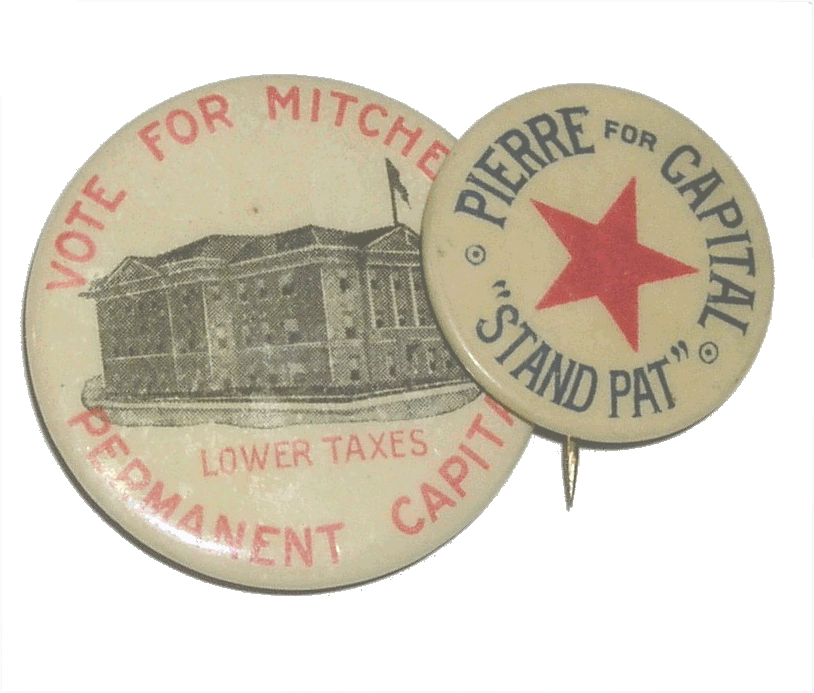|
How does one tell the history of our State Capitol without telling the tale of South Dakota itself?
Human beings have lived in what is today South Dakota for at least several thousand years. French and other European explorers in the 1700s encountered a variety of groups including the Omaha and Arikara (Ree), but by the early 1800s the Sioux (Dakota, Lakota, and Nakota) were dominant. In 1743, the LaVerendrye brothers buried a plate near the modern capital Pierre (pronounced as "peer") claiming the region for France as part of greater Louisiana. In 1803, the United States purchased the Louisiana Territory from Napoleon, though the native peoples inhabiting most of this area were not aware of the transaction.
President Thomas Jefferson organized a group called the Corps of Discovery, led by Meriwether Lewis and William Clark (commonly referred to as "Lewis and Clark Expedition"), to explore the newly-acquired region. In 1817, an American fur trading post was set up at present-day Fort Pierre, beginning continuous American settlement of the area. Through much of the 19th century, exploratory expeditions such as those of Lewis and Clark and Joseph Nicollet coincided with an increasing presence of the U.S. Army. In 1855, the U.S. Army bought Fort Pierre but abandoned it the following year in favor of Fort Randall to the south. Settlement by Americans and Europeans was, by this time, increasing rapidly, and in 1858, the Yankton, Dakota, and Sioux resigned themselves to signing the 1858 Treaty, ceding most of present-day eastern South Dakota to the United States.
In 1861, the Dakota Territory was recognized by the United States government. This area initially included North Dakota, South Dakota, and parts of Montana and Wyoming. During this time period, the towns of Bismarck, Huron, Yankton and Pierre all served terms as the capital city.
First Territorial Capitol in Yankton - 1866Settlers from Scandinavia, Germany, Ireland, and Russia, as well as elsewhere in Europe and from the eastern U.S. states, increased from a trickle to a flood, especially after the completion of an eastern railway link to the territorial capital of Yankton in 1872, and the discovery of gold in the Black Hills in 1874 during a military expedition led by George A. Custer.
This expedition took place despite the fact that all of Dakota Territory west of the Missouri River (along with much of Nebraska, Montana, and Wyoming) had been granted to the Sioux by the Treaty of 1868 as part of the Great Sioux Nation. The Sioux declined to grant mining rights or land in the Black Hills, and war broke out after the U.S. failed to stop white miners and settlers from entering the region.
And on November 2, 1889, Dakota Territory was incorporated into the United States as the modern states of North Dakota and South Dakota.
When South Dakota became an independent state it was decided that it was also time to establish a permanent capital city. Many towns campaigned for this position, very much like a political campaign. The city of Pierre, in fact, went into debt for 30 years because of the amount of money they spent on their campaign. The central location of Pierre (pronounced "peer") within South Dakota is what helped the current Capital City win the campaign.
Outgoing Governor Herried in his message to the 1905 Legislature said "South Dakota needs a new statehouse, fireproof and commodious and in harmony with its progress and prosperity."
Our Capitol building was built between the years of 1905 and 1910. The more than 114,000 square foot structure was constructed of a variety of materials, including native field stone, Indiana limestone, and Vermont and Italian marble. The structure is 161 feet tall, 190 feet wide, and 292 feet long and features hundreds of handcrafted materials including carved woodwork and marble, special cast brass, and hand laid stone.
Our photographic tour through the Capitol will take you through its rich and colorful history from the time of it's construction in the early 1900's to a series of repairs in the mid 1960's. Finally, over a 13 year period beginning in 1976 and reaching it's conclusion in 1989 - the year of the South Dakota State Centennial - a full restoration was conducted bringing the Capitol into it's current restored state.
Copyright 2007 South Dakota Bureau of Administration | Frontpage-Templates.org | E-Mail BOA Webmaster


